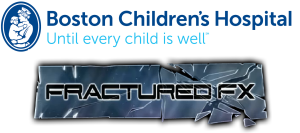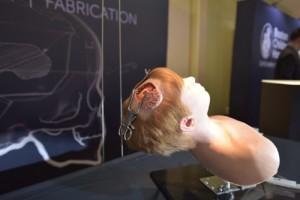3D Printed Surgical Models Just Got More Realistic Thanks to Fractured FX and Boston Children’s Hospital
 I went to a tiny liberal arts college in the middle of nowhere, with no bars within walking distance, so that meant that a lot of time was spent in my friends’ dorm rooms watching movies. As most of my friends were guys, those movies were most often terrible, dated cult horror films with laughable special effects and gratuitous, obviously fake violence. Special effects have come a long way since I graduated from college. Effects companies now have access to the kind of technology that allows murder and death to be disturbingly realistic (thanks for the nightmares, Game of Thrones). Much of this technology involves 3D printing, and, thanks to companies such as Fractured FX, it’s now being used for good as well as evil.
I went to a tiny liberal arts college in the middle of nowhere, with no bars within walking distance, so that meant that a lot of time was spent in my friends’ dorm rooms watching movies. As most of my friends were guys, those movies were most often terrible, dated cult horror films with laughable special effects and gratuitous, obviously fake violence. Special effects have come a long way since I graduated from college. Effects companies now have access to the kind of technology that allows murder and death to be disturbingly realistic (thanks for the nightmares, Game of Thrones). Much of this technology involves 3D printing, and, thanks to companies such as Fractured FX, it’s now being used for good as well as evil.

Trainer, made by Fractured FX, shows neuroscientists the opening flap made in the scalp to prepare for endovascular third ventriculostomy (ETV) surgery. [Photo: PR Newswire]
An increasing number of hospitals have been using 3D printing to create accurate replicas of patients’ organs so that surgeons can practice complex surgeries before the patient gets on the table. Most 3D printed replicas are extremely detailed and accurate as they’re modeled from the patients’ MRI scans, but Boston Children’s Hospital is taking it a step further. With help from Fractured FX, their surgical models will now bleed, pulsate, and otherwise feel completely realistic when doctors operate on them.
“This is the nexus of medicine and art, surgery and cinema,” said SIMPeds Director Peter Weinstock, MD, PhD. “Getting the look and feel right is very important, particularly to surgeons and proceduralists. To make simulations effective, you want to promote suspension of disbelief, to create an environment where everyone is believing that they’re working on a real child. Other simulators exist but their aesthetics and anatomy are fairly rudimentary, making it hard to keep people’s heads in the game. We’re excited to have these new simulators change that.”

A side-by-side image of a real patient brain (Left) undergoing ETV surgery as compared to the Fractured FX brain (Right) during the same critical moment of the procedure [Image: PR Newswire]
The idea for the partnership was conceived by Weinstock, who saw Fractured FX’s work in the Cinemax medical drama The Knick and contacted them about a possible collaboration. Discussions between the two organizations began in 2014, and earlier this year, they began prototyping the first surgical models.
“A lot of us had aspirations in medicine, and have collaborated with prosthesiologists to help improve prosthetics artistically,” said Fractured FX CEO Justin Raleigh. “We wanted to take our skills in special effects to try and help people. We’ve had to come up with new techniques to develop the elements you’d see in surgery, something we never had to do for film. It’s been a really nice back and forth working with actual surgeons and getting their input and knowledge. We’ve been getting a crash course in surgery, and the SIMPeds engineers have come to our studio to learn about manufacturing techniques and how we process materials and make molds. It’s been very educational in both directions.”
Boston Children’s Hospital and Fractured FX hope to begin offering the models commercially to other hospitals and medical centers soon. With this partnership, special effects, so often used to convey death and destruction, are now moving into a new realm: preserving life. Let us know your thoughts on this partnership in the 3D Printed Medical Model forum thread on 3DPB.com.
Subscribe to Our Email Newsletter
Stay up-to-date on all the latest news from the 3D printing industry and receive information and offers from third party vendors.
You May Also Like
Profiling a Construction 3D Printing Pioneer: US Army Corps of Engineers’ Megan Kreiger
The world of construction 3D printing is still so new that the true experts can probably be counted on two hands. Among them is Megan Kreiger, Portfolio Manager of Additive...
US Army Corps of Engineers Taps Lincoln Electric & Eaton for Largest 3D Printed US Civil Works Part
The Soo Locks sit on the US-Canadian border, enabling maritime travel between Lake Superior and Lake Huron, from which ships can reach the rest of the Great Lakes. Crafts carrying...
Construction 3D Printing CEO Reflects on Being Female in Construction
Natalie Wadley, CEO of ChangeMaker3D, could hear the words of her daughter sitting next to her resounding in her head. “Mum, MUM, you’ve won!” Wadley had just won the prestigious...
1Print to Commercialize 3D Printed Coastal Resilience Solutions
1Print, a company that specializes in deploying additive construction (AC) for infrastructure projects, has entered an agreement with the University of Miami (UM) to accelerate commercialization of the SEAHIVE shoreline...






























